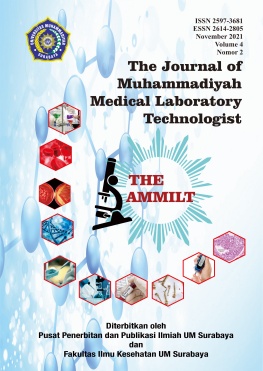Isi Artikel Utama
Abstrak
Ciplukan leaves (Physalis angulata L.) and Cinnamon (Cinnamomum burmannii) are one of medicinal plants that contain antibacterial active compounds. This study aims to determine the antibacterial activity of the combination formula between extracts of ciplukan leaves and cinnamon sticks against the growth of Staphylococcus aureus bacteria in Vitro. Ciplukan leaves (Physalis angulata L.) and cinnamon (Cinnamomum burmannii) were extracted by the maceration method with 70% ethanol. Ciplukan leaf extract (Physalis angulata L.) and cinnamon (Cinnamomum burmannii) were tested against Staphylococcus aureus bacteria using the good method by measuring transmittance on a spectrophotometer at a wavelength of 580 nm with 3 repetitions, 100 ppml standard Septromycin solution as control positive and aquadest as a negative dick. Inhibition zone diameter of ciplukan leaf extract (Physalis angulata L.) x̄ = 12.46 mm, Cinnamon Extract (Cinnamomum burmannii) x̄ = 18.93 mm, while in the formulation group x̄ = 22.45 mm. One-way analysis of variance (ANOVA) of these data compared with Streptomycin activity (positive control) showed significant inhibitory activity by the formulated extract against S. aureus.
Â
Keywords: Antibacterial, Staphylococcus aureus,  Ciplukan leaves (Physalis angulata L.) and Cinnamon (Cinnamomum burmannii)
Rincian Artikel
Referensi
- Bastos, G., Silveira, A., Salqado, C., Picanco-Diniz, D., & Nascimento, J. (2008). Physalis angulata extract exerts anti- inflammatory effects in rats by inhibiting different pathways. Ethnopharmacol, 118 (2): 246-251.
- Bazargani MM, & Rohloff J. (2016). Antibiofilm activity of essential oils and plant extracts against Staphylococcus aureus and Escherichia coli biofilms. Food Control, 156-164.
- CDC, C. f. (2021, November 29). Active Bacterial Core Surveillance Report, Emerging Infections Program Network, Methicillin- Resistant Staphylococcus aureus, 2014. Indonesia.
- Cin , K., Hui-min , N., & Sheila , N. (2016). Targeting Staphylococcus aureus Toxins: A Potential form of Anti-Virulence Therapy. Toxins.
- Dantes, R., Mu, Y., & Belflower, R. (2013). National burden of invasive methicillin-resistant Staphylococcus aureus infections, United States, 2011. JAMA Intern Med, 1970–1978.
- De Kraker, M., Jarlier, V., Monen, J., Heuer, O., van de Sande, N., & Grundmann, H. (2013). The changing epidemiology of bacteraemias in Europe: trends from the European Antimicrobial Resistance Surveillance System. Clinical Microbiology and Infection, 860–868.
- Mellisa, T., Sonia, M., Terezinha, G., Batista, P., & Therezinha, C. (2005). Studies on antimicrobial activity, in vitro, of Physalis angulata L. (Solanaceae) fraction and Physalin bringing out the Importance of Assay Determination. Mem Inst Oswaldo Cruz, 100(7):779-82.
- Nostro, A., GermanÅ, M., D’AngeloV, Marino, A., & Cannattelli, M. (2000). Extraction methods and bioautography for evaluation of medicinal plants for antimicrobial activity. Lett Appl Microbiol, 5(30), 379-384.
- Onakoya , Z., & Akinpelu , D. (2006). Antimicrobial activities of medicinal plants used in folklore remedies in South-Western, Afr. Biotechnol, 5, 1078- 1081.
- Prashanth, K., Neelam, S., Chauhan, S., Harishpadhi, B., & Ranjani, M. (2006). Search for antibacterial and antifungal agents from selected Indian medicinal plants. Ethanopharmacol, 107,182-188.
- Paratrick, R., Rosenthal, K., Kobayashi, G., & Pfaller, M. (1998). Medical Microbiology (242-243 ed.). USA: Mosby publication.
- Scallen E, Hoekstra RM, Angulo FJ, Tauxe RV, Widdowson MA, & Roy SL. (2011). Foodborne illness acquired in the United States-major pathogens. Emerg. Infect, 7-15.
- WHO, W. H. (2019, April 10). Retrieved from https://www.who.int/news-room/fact-sheets/detail/food-safety
- Zhang, Y., Liu, X., Wang , Y., Jiang , P., & Quek , S. (2015). ntibacterial activity and mechanism of cinnamon essential oil against Escherichia coliand Staphylococcus aureus. Food Control, 59, 282–9.
Referensi
Bastos, G., Silveira, A., Salqado, C., Picanco-Diniz, D., & Nascimento, J. (2008). Physalis angulata extract exerts anti- inflammatory effects in rats by inhibiting different pathways. Ethnopharmacol, 118 (2): 246-251.
Bazargani MM, & Rohloff J. (2016). Antibiofilm activity of essential oils and plant extracts against Staphylococcus aureus and Escherichia coli biofilms. Food Control, 156-164.
CDC, C. f. (2021, November 29). Active Bacterial Core Surveillance Report, Emerging Infections Program Network, Methicillin- Resistant Staphylococcus aureus, 2014. Indonesia.
Cin , K., Hui-min , N., & Sheila , N. (2016). Targeting Staphylococcus aureus Toxins: A Potential form of Anti-Virulence Therapy. Toxins.
Dantes, R., Mu, Y., & Belflower, R. (2013). National burden of invasive methicillin-resistant Staphylococcus aureus infections, United States, 2011. JAMA Intern Med, 1970–1978.
De Kraker, M., Jarlier, V., Monen, J., Heuer, O., van de Sande, N., & Grundmann, H. (2013). The changing epidemiology of bacteraemias in Europe: trends from the European Antimicrobial Resistance Surveillance System. Clinical Microbiology and Infection, 860–868.
Mellisa, T., Sonia, M., Terezinha, G., Batista, P., & Therezinha, C. (2005). Studies on antimicrobial activity, in vitro, of Physalis angulata L. (Solanaceae) fraction and Physalin bringing out the Importance of Assay Determination. Mem Inst Oswaldo Cruz, 100(7):779-82.
Nostro, A., GermanÅ, M., D’AngeloV, Marino, A., & Cannattelli, M. (2000). Extraction methods and bioautography for evaluation of medicinal plants for antimicrobial activity. Lett Appl Microbiol, 5(30), 379-384.
Onakoya , Z., & Akinpelu , D. (2006). Antimicrobial activities of medicinal plants used in folklore remedies in South-Western, Afr. Biotechnol, 5, 1078- 1081.
Prashanth, K., Neelam, S., Chauhan, S., Harishpadhi, B., & Ranjani, M. (2006). Search for antibacterial and antifungal agents from selected Indian medicinal plants. Ethanopharmacol, 107,182-188.
Paratrick, R., Rosenthal, K., Kobayashi, G., & Pfaller, M. (1998). Medical Microbiology (242-243 ed.). USA: Mosby publication.
Scallen E, Hoekstra RM, Angulo FJ, Tauxe RV, Widdowson MA, & Roy SL. (2011). Foodborne illness acquired in the United States-major pathogens. Emerg. Infect, 7-15.
WHO, W. H. (2019, April 10). Retrieved from https://www.who.int/news-room/fact-sheets/detail/food-safety
Zhang, Y., Liu, X., Wang , Y., Jiang , P., & Quek , S. (2015). ntibacterial activity and mechanism of cinnamon essential oil against Escherichia coliand Staphylococcus aureus. Food Control, 59, 282–9.

